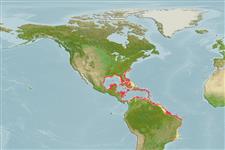Common names from other countries
Environment: milieu / climate zone / depth range / distribution range
Ecologia
marinhas associadas(os) a recifes; intervalo de profundidade 3 - 40 m (Ref. 9626). Subtropical; 39°N - 23°S, 99°W - 30°W
Western Atlantic: Chesapeake Bay, through the Gulf of Mexico and Caribbean southward to Brazil. Including Antilles (Ref. 26938).
Length at first maturity / Tamanho / Peso / Idade
Maturity: Lm 18.3, range 11 - 23.23 cm
Max length : 53.0 cm TL macho/indeterminado; (Ref. 40637); common length : 30.0 cm TL macho/indeterminado; (Ref. 3798); peso máx. Publicado: 4.4 kg (Ref. 4699)
Espinhos dorsais (total): 12; Raios dorsais moles (total): 17; Espinhos anais 3; Raios anais moles: 9. Side of head has narrow blue stripes; scales above lateral line much larger than those below (Ref. 26938). Scale rows just below lateral line oblique; color variable but usually light yellowish (Ref. 13442).
Found in dense aggregations during the day on patch reefs, around coral formations, or on sandy bottoms (Ref. 9710). Juveniles common in Thalassia testudinum beds (Ref. 5217). Feeds on crustaceans, small mollusks, and small fishes. Frequently exhibits a territorial 'kissing' display in which two contenders push each other on the lips with their mouths wide open (Ref. 9710). Marketed fresh. Has been reared in captivity (Ref. 35420).
Oviparous, distinct pairing during breeding (Ref. 205).
Courtenay, W.R. and H.F. Sahlman, 1978. Pomadasyidae. In W. Fischer (ed.) FAO species identification sheets for fishery purposes. Western Central Atlantic (Fishing Area 31), Volume 4. FAO, Rome. (Ref. 3798)
Categoria na Lista Vermelha da IUCN (Ref. 130435)
Can't connect to MySQL database (fbapp). Errorcode: Too many connections
